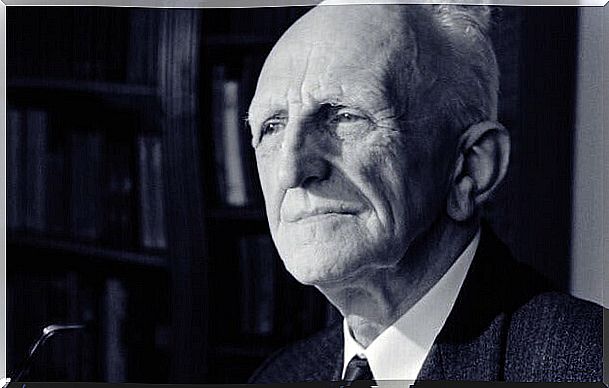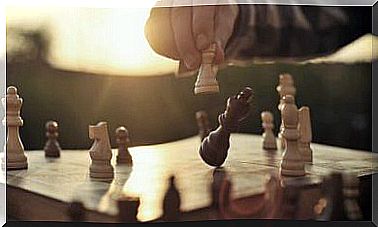Donald Winnicott And His Theory Of The False Self

Donald Winnicott was a famous English psychiatrist, psychoanalyst, and pediatrician who developed an interesting approach to personality. Due to his training as a pediatrician, he focused his reflections on children. Particularly in the relationship between the mother and the nursing baby and the consequences that arise from this.
He worked alongside the famous psychoanalyst Melanie Klein, even treating one of his own children. He was also president of the British Psychoanalytic Society and a very famous thinker of the 20th century.
One of his most interesting contributions is that of the false self (himself) or false self. Also her concepts of “good enough mother” and “banally dedicated mother”. Similarly, his concept of “transitional object” has been adopted by many schools of psychology.
The relationship between mother and baby, according to Winnicott
In line with other psychoanalysts, Winnicott argues that during the first year of life the mother and the child constitute a unit. You cannot speak of the baby as a separate entity from its mother. The two make up an indivisible psychic unit.

Winnicott says that the mother is the first environment that a human being has. The total basis of its further development. Therefore, and especially in the first months of life, the mother is the baby’s universe. The world is practically a synonym for the mother.
Then the concept of “good enough mother” appears. This is the one that provides the necessary care to the baby, spontaneously and sincerely. She is willing to be that base and that environment that the child needs. Without being perfect, she does not overindulge, nor does she neglect the baby. This mother gives rise to a true self, or true self.
Meanwhile, the “banally dedicated mother” is one who develops an excessive attachment or overprotection of her child. Also the one that is not able to respond to the spontaneous manifestations of the child. She gives rise to what Winnicott calls false self or “false self.”
Winnicott and the false me
The mother is like a mirror for the child. The little boy sees himself as she looks at him. Learn to identify with the human race through it. Little by little, the baby is separating from his mother and she must adapt to it. The child has spontaneous gestures that are part of his individuation. If the mother welcomes them, he experiences the feeling of being real. Failure to do so creates a feeling of unreality.

When that interaction between mother and baby fails, what Winnicott calls a “cut through existential continuity” occurs. This, in other words, means a radical interruption of the spontaneous development of the baby. This is what gives rise to the false self or false self.
Winnicott points out that in these circumstances, the baby becomes “the mother of himself.” This means that he begins to hide his own self to protect himself. Learn to show only what, so to speak, your mother wants to see. It becomes something that it is not really.
The effects of the false self
There are various levels of falsification in the self. According to Winnicott, at the most basic level are those who adopt a courteous attitude and fully adapted to the rules and mandates. At the other extreme is schizophrenia, a mental condition in which the person is dissociated, to the point where their real self virtually disappears.
For Winnicott, a false self predominates in all serious mental pathologies. In this case, the person uses all the resources available to structure that false self and maintain it. The purpose of this is to face a world that you perceive as unpredictable or unreliable.
Winnicott indicates that a good part of the efforts of a person with a very strong false self are aimed at the intellectualization of reality. That is, to turn reality into an object of reason, but not of emotions, affections or creative acts. When such intellectualization succeeds, the individual is perceived as normal. However, he does not experience what he experiences as his own, but as something alien.

He cannot feel happy about his triumphs, or feel valued even if he is. For him, it is his false self who has achieved it or who is being valued. With this, he marks a break with himself and with the world. His true self is confined, fantasizing and experiencing a discomfort that he never understands on his own.
Is there really a I?
An interesting debate about the real existence of the “I” could be added to Winnicott’s theory. In order to exist a “false me” there must first be a “me”. From Buddhist Psychology you can start a very interesting conversation with Winnicott’s “false self”. In essence, Buddhist Psychology affirms that nothing exists as we believe it exists. This corresponds to the concept of Emptiness.
We tend to understand the “I” as a static and immutable entity with the passage of time. We identify with and cling to self out of fear of loss of identity. However, everything changes, including our “I”. Therefore, our “I” of a year ago would not be the same as the “I” of today. So the existence of a self is there, but self in the way we believe. Winnicott affirms that the individual is capable of falsifying the self, therefore, according to his theory, a person would have the power to change the “self”. This aspect becomes relevant since, together with Buddhist Psychology, it supports the theory of a changeable and non-static “I”.
Winnicott’s ‘me’ could ultimately be seen as a socially expected ‘me’. Like the “me” that predominates today. We build an “I” that adapts, but do we feel identified with it? Our “I” is correct, but we observe everything from a distance because we do not believe that it is us. With which, from Buddhist Psychology we can delve into this theory from another point of view and adapt it to ourselves to try to find that real and changeable “I” and know who we really are.









